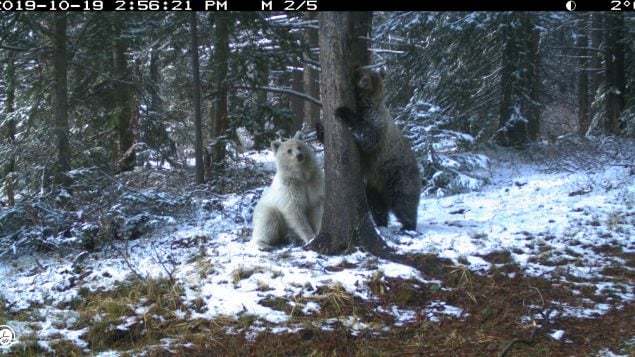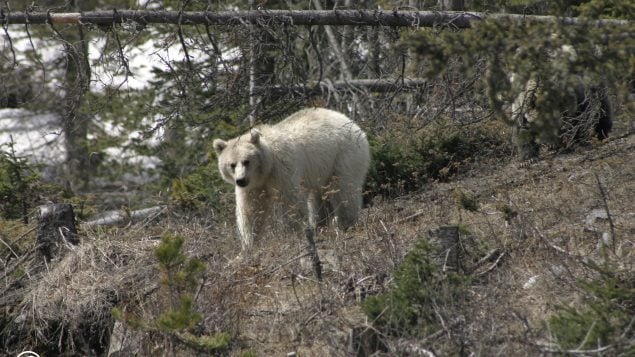Gorgeous Rare White Grizzly Bear Sighted In Canada
Language
Reading Level
Listen to Article

With less than 55,000 grizzly bears left in the wild across North America, the sighting of even one is a cause for celebration. Hence you can only imagine how delighted Cara Clarkson and her family were when they spotted two young grizzlies — one with rarely seen all-white fur— foraging alongside the Trans-Canada Highway near Banff, Canada, on April 26, 2020.
"We knew we were so lucky because white grizzly bears are unheard of," Cara told St. Albert Today. "It was a luxury and experience for those of us who were driving by." The Director of Operations at the Rimrock Resort Hotel in Banff, who shared her images and video on social media, said the sighting was a real treat given that the family was out celebrating two birthdays — her husband Tyler's on April 26 and her three-year-old son Beau's on April 24.
Mike Gibeau, a carnivore specialist for Parks Canada and an adjunct professor in the Geography Department at the University of Calgary, says the Clarksons and other motorists who have encountered the white bear — now called Nakoda, which means "friend" or "ally" in the native language of the area's three Aboriginal tribes — are truly lucky. For, though there are a few variations of white bears to be found, such as the Kermode bears in British Columbia and the polar bears in the Arctic, white grizzly bears are extremely rare. "I have never in all my time working with grizzly bears--since the early 1980s--seen a white grizzly bear. I've seen a really, really blond grizzly, but never a white one," Gibeau told St. Albert Today.

The expert doesn't believe the grizzly's white fur is a case of albinism, a disorder in which a mammal fails to produce melanin, a group of pigments responsible for skin, hair, and eye color. Instead, he thinks the bear's unusual coloring is the result of a recessive gene. As the name suggests, the characteristics of recessive genes are often masked by those of dominant genes. However, if both parents carry the same recessive gene — in this case, one that results in white fur — it can be passed on to the offspring.
Though this is the first time the world has seen the white grizzly, park rangers have known of Nakoda's existence since 2018. Jon Stuart-Smith, a Parks Canada wildlife management specialist for Lakes Louise, Yoho, and Kootenay, says his team first spotted the bear and its sibling as cubs traveling with their mother, who they tracked from 2012 to 2017 as part of a Canadian Pacific-Parks Canada research project to analyze the mortality rates of the region's grizzly bears.
Nakoda and its sibling were seen again in 2019, this time without their mother, feeding off the grain spilled due to a train derailment in Yoho National Park. The smart bears, who venture back and forth between Banff and Yoho National Park, returned to the area earlier this year but left after realizing the grains had been cleared, and there was nothing left to eat. The park officials never publicized the unique bear due to fear that it would be relentlessly chased by fans eager to catch a glimpse. "These unusual-looking animals get hunted ruthlessly by photographers, and so the less we talk about them, the better," Gibeau told The Guardian in an e-mail.

As it turns out, the experts were right. Nakoda's photos and videos, which have gone viral, have led to a flurry of people rushing to the bear's current location and resulted in unsafe parking and traffic jams. To protect the animals, on June 18, 2020, the concerned officials imposed a 10-kilometer no-stopping zone along the section of the Trans-Canada Highway where the two young grizzlies and several black bears have been sighted feeding on dandelions and berries. Violators will be fined anywhere from $85 (115 CAD) to as much as $18,500 (25,000 CAD). "We hope this informs visitors to travel through the area safely and to prevent these bears from getting hit on the highway," said Stuart-Smith.
Meanwhile, wildlife experts are trying to steer the young grizzlies away from the highway as much as they can. "We want them to develop a behavior of avoidance of humans, and especially vehicles and the highway at this point," Stuart-Smith said. "They're just young bears trying to figure out how to make a living on the landscape, and haven't had enough time to know they should be avoiding the highway and avoiding people." The officials hope that the three-and-a-half-year-old grizzly siblings will eventually head to higher elevations and disappear into the forests, where they can live a long, healthy life. "We all want Nakoda the White Grizzly to eventually become Nakoda the 'Great' White Grizzly of Banff National Park area," they wrote on a Facebook post.

Nakoda is not the only grizzly capturing headlines. On June 18, 2020, Julia Turner Butterwick and her family stumbled upon a mama grizzly with two cubs, including one with a white head, in Banff National Park. "As we got closer, we saw there were two cubs beside her," Turner Butterwick told The National Post. "I said, 'That cub has a white head. 'My four-year-old son thought it was great — he thought it was a panda."'
Of course, the discovery came as no surprise to Parks Canada officials. "One sibling is brown while the other is brown with a blonde head and chest," the agency said in a statement. "The blonde color is caused by a color phase variation which is unusual but natural." The experts believe the cubs are about six months old and will probably remain by their mother's side until they are a year old.
Resources: prevention.com, newsweek.com, stalberttoday.ca. theguardian.com